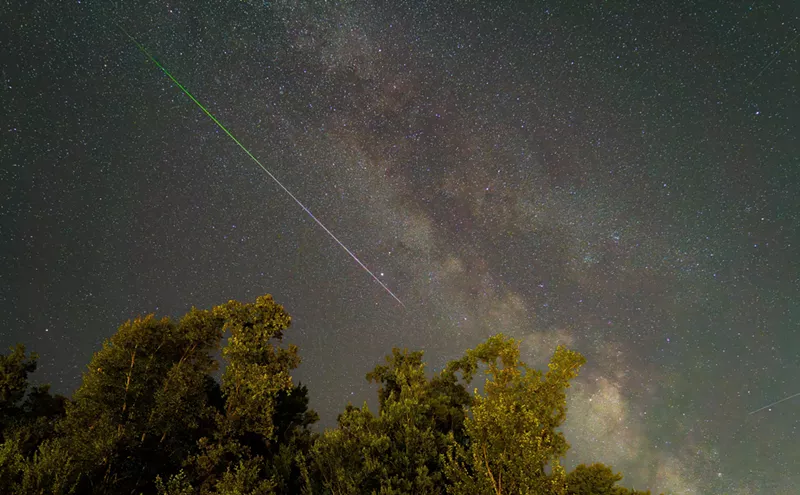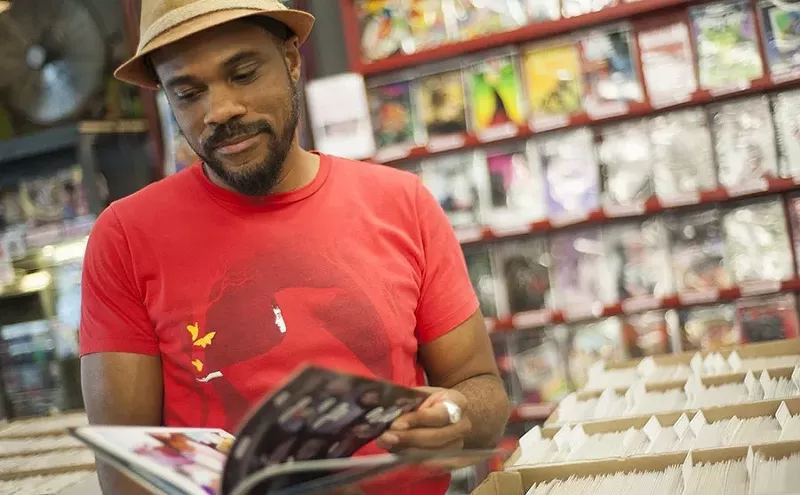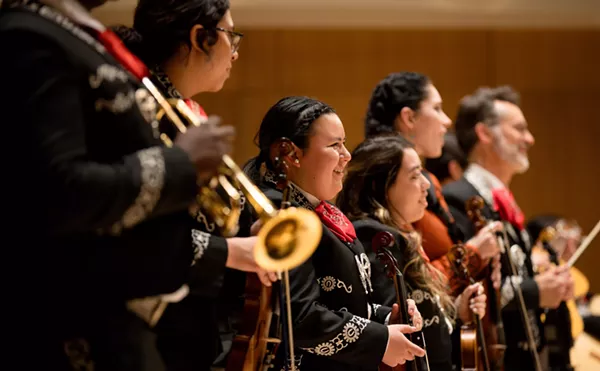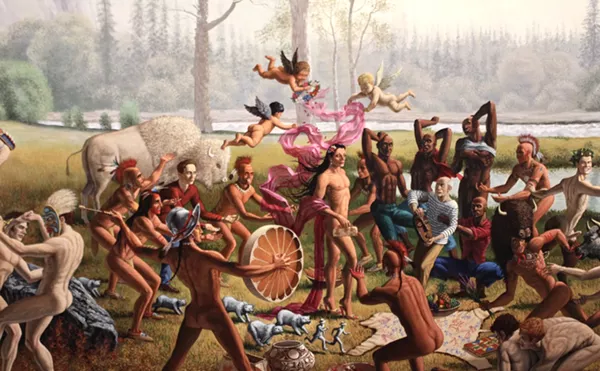All of Folkestad's installations have addressed the same topic--the tension between nature and culture--and there has always been a subtle male-versus-female subtext as well. But these two themes have never been more clearly expressed than in Folkestad's current triumph, Musical Chairs: A Competition for Position, now on display at the Arvada Center for the Arts and Humanities.
Another signature characteristic of Folkestad's pieces is their fine, high-quality construction. Despite the wide variety of techniques employed, just about everything is done by the artist herself: Folkestad is an expert not just at sculpting, but also at detailed welding and cabinetmaking. Just as she uses many techniques, she always incorporates a unique set of materials in her work, stretching from delicate and ephemeral to durable and permanent. In the past, she's used everything from dried leaves to reinforced concrete; in Musical Chairs, her materials range from meticulously carved wax niches to large found rocks.
For the Arvada show, Folkestad created four components that could stand as individual installations but were conceived as coming together into the single "Musical Chairs" piece. It begins in the dimly lit entry gallery on the lower level of the Arvada Center, where the viewer encounters a crate-like stand made of unfinished lumber that's surmounted by a handsome polished steel cage. A long green stem pokes through the cage, originating from a crack in the stand; a series of nine raw-wood boards set up like sawhorse legs supports the rest of the attenuated stem. "The plant grows through the crack in the box, like the plants that come up through the asphalt," says Folkestad. "It refers to the title, 'Musical Chairs: A Competition for Position.' It's about the conflict of nature and culture."
This first element directs the viewer inexorably toward the second, a corridor to the left. Visible from the entrance is a grid of lighted niches that mark the corridor's halfway point. "The lights in the dark hall lead people in; they see the glow from the front," says Folkestad. "It's like a painter. The eye is meant to travel in a certain way across a painting. Here I guide the viewer through the space." In doing so, she creates a specific sequence of sights.
The lighted niches are exquisite. Folkestad carved wax to create them, then carved transparent glycerine to create the primordial seed and seashell forms placed inside. "The shapes have no specific meaning," she explains. "They're generic organic--seeds, roots--staying with the nature theme."
More light, as well as the high-pitched whirring of an electric motor, lures the viewer on. At the third phase of Folkestad's "Musical Chairs," the space opens, and brightens, up. Filling the well-lit gallery is a grid of swings suspended by thick ropes from an elaborate, black-painted metal mechanism mounted on the ceiling. The swings sway rhythmically, in unison, at a fairly speedy clip. Each seat consists of a pair of unfinished plywood boards with a pillow sandwiched between them; the whole thing is clamped tightly together with oversized nuts and bolts, and the top of the seat is covered by a mass of upright twigs that suggest miniature forests. "The pillows are culture, which is squeezed by nature like a flower in a flower press," says Folkestad.
Although "Musical Chairs" is her first installation to incorporate movement, Folkestad had been thinking about it for some time. "Nature is always moving," she says, "so I wanted to include movement in the piece, but I had no background in it." To work out the technical details, she collaborated with mechanical engineer Michael Constant.
The relentless swinging directs the viewer to the fourth part of the installation, its heart, which fills the two-story atrium from side to side and top to bottom. In the center of the space is a large, tent-like construction reminiscent of a gazebo or large aviary. Folkestad has constructed this enclosure with polished steel rods, bent at an angle and set vertically on fragments of salvaged iron railings topped with large, smooth river rocks. The angled rods, in turn, hold up large, elaborately and expressively folded metal screening that serves as the enclosure's walls. These hanging screens are encircled by a series of black welded-steel rectangles that frame them visually.
Hanging above the enclosure is a dense tangle of bird perches suspended from a white painted grid on the ceiling; the perches have been made with heavy wire and unfinished wooden dowels. On each perch is a small green tube knitted from yarn. "I wanted to suggest the green canopy of leaves, or the green color of parrots," Folkestad says. The perches sway gently in a breeze created by small electric fans discreetly attached high on the wall. The fans were a last-minute addition to a show that otherwise was a year in the planning and preparation. "With the movement of the swings, the perches had to move just to hold their own," explains Folkestad.
This last part of "Musical Chairs" has a hidden feature. Slightly off to the right, a passage leads through the walls of the enclosure. Inside, under the canopy of perches, is a chamber created by the hanging metal screening. It's empty, save for a white sculpture stand set directly opposite the opening and stacked with postcards tied into bundles with thread.
According to Folkestad, this final part is "about keeping nature outside." But taken together with the installation's penultimate feature, the swings, the ultimate stage is also about sexuality. It doesn't take Freud to interpret the relationship between the constant to-and-fro of the swings and the almost hidden entrance of the womb-like chamber opposite. In this show rife with references to nature and culture, there's also no missing the import of the title: One or the other will grab the last chair--and Folkestad's banking on nature.
In contrast to Folkestad's poetic ambiguity, another regional installation-art star, John McEnroe, is sardonic and direct. He's also a prankster, as evidenced by the artist's statement for his current exhibition, Plastique, at ILK It's a page of tool ads from a newspaper.
McEnroe, an adjunct art professor at Metro (he's currently on leave), has long been interested in using mundane, everyday objects in his work. Since coming to Denver five years ago, he has exhibited such articles as panels of floor covering and stacks of plastic plates. For Plastique, though, McEnroe cast ordinary items in Dupont Elvax, an easy-to-use plastic, instead of displaying assemblages of ready-made objects. "I seriously considered showing brand-new things," he explains, "but then I found this technology for plastic casting. With this plastic, I can control the color better than with paint, so I was able to get all these designer colors." The pastels and jewel-toned colors are a change for McEnroe, who previously used the primaries exclusively.
While McEnroe may be better known for exhibiting ready-mades, he's hardly a stranger to plastic fabrication. Since 1995 he's been a studio assistant for the legendary John DeAndrea, making molds, casting sculptures in vinyl and chasing the finished cast. And even before McEnroe began his association with DeAndrea, he was interested in plastic as an art material. The stunningly minimal piece "Red Hot," essentially a red plastic shower curtain that hangs across the small ILK @ PIRATE SPACE, DATES BACK TO 1994 AND WAS MADE BY MCENROE JUST BEFORE HE CAME TO DENVER FROM OHIO. THE INTENSITY OF THE COLOR AND THE HEAVY DRAPE OF THE LATEX-SATURATED FABRIC ADD MONUMENTALITY TO THIS OTHERWISE SEEMINGLY PROSAIC ARTICLE.
OTHER THAN "RED HOT," EVERYTHING IN PLASTIQUE WAS MADE FOR THE SHOW, A GROUP OF RELATED PIECES THAT SOMETIMES BLUR THE LINE BETWEEN INSTALLATION AND SCULPTURE. MCENROE BOTH LAMPOONS AND HONORS SUBURBAN LIFE WITH THESE BRIGHTLY COLORED PLASTIC CASTS; THE IMPETUS FOR THE SHOW, HE SAYS, IS THE FEELING "EVERY GOOD AMERICAN GETS AT HOME DEPOT."
IN "CHICAGO SPECIAL," THE FIRST CAST-PLASTIC PIECE HE DID, MCENROE LINES UP A SERIES OF NINE CASTS BASED ON DIFFERENT TOILET PLUNGERS. "AT FIRST I CONSIDERED CASTING THE PLUNGERS IN BRONZE, BUT THAT WOULD HAVE BEEN VERY COSTLY," HE SAYS. "THEN I FOUND ELVAX." SINCE THE CASTS ARE EXHIBITED IN THE RAW STATE THEY HAVE WHEN THEY EMERGE FROM THE MOLD, THEY DON'T LOOK LIKE ACTUAL PLUNGERS. "I LIKE THE APPEARANCE OF THE CASTING WHEN IT FIRST COMES OUT," HE EXPLAINS.
CONTINUING THE SUBURBAN THEME IS "LAWN BOY," A CAST OF A LAWNMOWER THAT'S HIDDEN BEHIND "RED HOT." THE PLASTIC BODY OF "LAWN BOY," WHICH SPORTS A REAL HANDLE, WAS MADE FROM MCENROE'S "SLOSH PIT" OF SURPLUS PLASTIC. AS A RESULT, ITS SURFACE IS COVERED WITH MULTI-COLOR SWIRLS.
THE CENTERPIECE OF PLASTIQUE IS "PASSION FRUIT & OTHER HEAVY-DUTY EQUIPMENT," A WALL COVERED WITH SCORES OF RAINBOW-HUED CASTS OF TOOLS. THESE SCULPTURES, WHICH MCENROE ENVISIONS AS "HAPPY MEAL TOOLS FOR ADULTS," HAVE BEEN MOUNTED ON FACTORY-PRODUCED WIRE BRACKETS IN THE MANNER OF A STORE DISPLAY (AND NOT UNLIKE THAT TOOL-AD ARTIST'S STATEMENT, WHICH HANGS ADJACENT TO "PASSION FRUIT"). THE TOOLS, WHICH INCLUDE A GIANT PIPE WRENCH, A WEED TRIMMER AND A WIDE ARRAY OF HAMMERS, ARE QUITE BEAUTIFULLY MADE AND COLORED; MCENROE'S INSTINCTUAL AND SEEMINGLY RANDOM ARRANGEMENT FURTHER ENHANCES THE VISUAL EFFECT.
MCENROE'S PLASTIQUE IS MORE MODEST, AND CONSIDERABLY LESS SERIOUS, THAN FOLKESTAD'S MUSICAL CHAIRS. NONETHELESS, IT HOLDS ITS OWN.
Musical Chairs: A Competition for Position, through April 3 at the Arvada Center for the Arts and Humanities, 6901 Wadsworth Boulevard, 303-431-3939. Plastique: Recent Works by John McEnroe, through February 14 at ILK @ Pirate, 3659 Navajo Street, 303-615-5725.











